(Continued from Part 1. This concludes the article.)
PUTTING IT ALL TOGETHER
You now should have your holster and all the necessary pieces cut out. At this point there are a bunch of steps that need to be completed before final assembly. I’ll try to keep these all in the right order, or at least the order that I use, which has worked for me so far. Most of these steps require that the leather be damp/wet. Again, watching a few videos on the internet will help with understanding this process. Suffice it to say that for the following steps I use a small sponge, and a bowl of water to keep the leather damp for working it.
- Groove the edges of the leather where your stitches will go using a stitching groover. I actually used the groover on all the edges, not just where the stitches would go, because I thought that the groove would look nice on the finished holster.
- Use the spacer tool to mark where the holes need to be drilled/punched for your stitching. (or mark them out with a ruler and a pen). You only need to do the front half of the holster at this time.
- Drill or punch the holes for your stitches. Only do half the holster – the front. You will never get the holes to line up perfectly, so once the holster is glued you can use the holes as guides and punch the holes all the way through.
- You will now have a good idea of the space and shape of the area that you have available for tooling, carving, or decoration. It always looks a lot bigger on the pattern, but once you take into account your allowance for stitches, it shrinks up considerably.
- Draw, or transfer your design onto the holster. I wish that I had some secret for this, but I don’t. You could probably use tracing paper. I tend to work freehand, and draw the design lightly on the holster with a black ball point pen. If you are using stamps, like a basket weave pattern, you will want to draw some light lines with a pencil for reference to keep everything straight and level.
- Making sure that you keep the leather properly dampened you will be able to do your carving, or stamping into the leather.
- Important note: You can just leave the leather plain and it will work fine, and look good. If it is left plain it will also let you “wet form” the holster to your pistol later on. This is a process where the wet leather is molded/shaped to your gun with a stylus/burnishing tool. I’m sure you have seen numerous holsters done this way. If you choose to do this, it will be done after the holster is stitched. Manufacturers have plastic guns that they use for this, to produce multiple holsters exactly the same. You will have to use your expensive, antique for this process. Make sure your gun is well oiled, or it may rust due to the damp leather!
This is the design that I chose for this holster. I know that the subject matter may not be to everyone’s liking, but I saw a similar one on the internet that was done by a professional. I thought it was cool, and decided I would like to try something similar. There’s probably a proper way to darken the background, but I used a sharpie. You’ll also notice a couple water stains on the leather. Don’t worry to much about it, they should disappear once the leather is dyed.
CHOOSING A COLOR AND DYEING THE LEATHER
Pick a color that you like, follow the directions and dye your holster, and all the associated parts. I used “Saddle Tan” for this holster. Use a dauber or a small piece of foam rubber. Dye the inside and the outside for a uniform color. Wear disposable gloves, cause this stuff gets everywhere. Use a drop cloth! Your wife will not appreciate dye on her new table or counter top. In the past, I have waited until after I had stitched the holster to dye it. Trust me when I say that it is very difficult to get the inside of the holster, and the area around the belt loop dyed properly. Also, the dye will not penetrate any areas where there is glue, so you can wind up with undyed spots on your holster. (It’s very visible on a black holster)
Let it dry completely before continuing on to the next step.
I have the area outlined where the belt loop will go. You won’t see it once the belt loop is glued/stitched. The water stains can still be seen very faintly.
ATTACHING THE BELT LOOP, AND INSTALLING THE WELT
Stitching the belt loop needs to be done now, before stitching the rest of the holster. Once the holster is stitched it’s almost impossible to manipulate a needle, or anything else, inside it.
- Place contact cement on the back of the holster where you have marked it. Place contact cement on the end of the belt loop.
- Let it dry for the required time, and press it together. Work carefully, as this glue is very strong, and you’ll only get one chance to get it lined up.
- Mark and punch/drill the holes for your stitches. I always use two rows of stitches for added strength.
- Stitch the belt loop to the holster using the waxed thread and the darning needle. There are many different methods of stitching leather, and examples can be found on the internet. I use one needle, in a two forward – one back method, that I think is called a Modified Harness Stitch. It was shown to me years ago by an old harness/boot maker. It’s a strong stitch and leaves a pleasing design.
- Position the other end of the belt loop, and mark where it will be. Make sure that it falls within the body of the holster, and that it will not interfere with the holster stitching.
- Cut it to length, if necessary, and round the corners if you like.
- The bottom of the belt loop can be stitched in the same way as the top. For this particular holster I chose to go with a double snap set up. I’ve found two snaps to be more than strong enough for this purpose. It also allows the holster to be attached to a belt without removing the belt and threading on the holster. It can also be attached to closed loops, like on a pack, or on a western-style gun belt with the drop loop.
- Place contact cement on one side of the welt, and on one side of the holster. Let it dry the required time and then attach. It doesn’t matter if it’s glued to the front or rear side of the holster.
FINALLY…A HOLSTER
After all this work, it’s finally time to make a holster.
- Use contact cement on both sides of the holster. Only use it where the leather will be in contact. In this case, I am making an open-bottom holster, so I am not putting contact cement around the entire edge. I am leaving a gap where the leather won’t be in contact.
- Press the two sides of the leather together. Hold it tight with finger pressure until the contact cement has time to set. The stiff leather will want to spring open if you don’t maintain the pressure. Work carefully here, as once the contact cement comes together it will not want to come apart. Be sure that the edges line up – you only get one try at this.
- Punch your holes for stitching from the front, right through the back. The holes that you already have in the front will act as guides, and ensure that everything lines up properly.
- Stitch the holster with the waxed thread, using whatever your preferred stitching method.
FINISHING IT UP
At this point you now have a usable holster, but not a finished holster. There are still several steps to have that holster that you would get if you ordered one. Unfortunately, I forgot to take pictures of some of the steps, but I will try my best to cover what still needs to be done.
- Your holster will be glued/stitched together, but unless you are much more skilled than I am, your edges won’t match up perfectly. I have a belt sander in the shop, with a worn-out belt, that I use to make all the edges match up. This can also be done with some 220-grit paper on a dowel. Just sand the edge like you would if it was a piece of wood, until all the edges are smooth and even.
- At this point I use the Edge Beveler to take off the sharp edges, and leave a smooth finish. If you don’t have an Edge Beveler, this can be done with the sandpaper as well.
- The edges then need to be burnished, which is what gives them a slight shine. You can buy a burnisher from Tandy. I use an old whitetail antler tip. You just run it rapidly, with pressure, back and forth on the leather edge until it’s burnished. (shiny and smooth). This helps seal the edges.
- Seal the edges. I have some actual “Edge Sealer” that I picked up from Tandy, that I paint the edges with. In the past, before I knew the product even existed, I have used a black Sharpie, or a black paint pen. Both seemed to work satisfactorily.
- In the case of this holster, I needed to insert the revolver and measure the straps for the thumb break. Once I had the location for the first half of the snap, I punched a hole using my hole punch and set the snap. I then located where the second snap would be required, on the thumb break side, and repeated the process. All that’s left for this operation is to punch the hole for the other end of the thumb break and rivet it. Cut away any excess strap, and your thumb break should work.
- The entire holster then gets a good, heavy coat of leather preservative. I like the liquid silicone that they sell for water-proofing boots, but you can use mink oil, or neat’s-foot oil as well. This helps to preserve the leather and make it supple. It also seems to set the stain so that it won’t run or leach out of the holster.
- Maybe it’s because I’m ex-military, but after the preservative is dry, I always like to buff it to a shine with some good old-fashioned shoe polish. I use black on black holsters. All other colors get a good coat of neutral shoe polish. You could even spit-shine it if you wanted.
For the sake of honesty, I have to admit that everything on this project didn’t go as planned. I messed up with the thumb break, and it sits higher than I would have liked. It still works, but isn’t quite what I planned. There are also a couple other small mistakes on the holster, but being that I’m the photographer, I’ll just keep them hidden. You’d never see them in regular use anyway, unless you knew they were there, and you were looking for them.
As I stated at the beginning of this article, I am not a professional, or even hobbyist, leatherworker. My leatherwork is more a labor of love and necessity. If you have followed through this entire article, you now know how many steps are involved, and have an idea of the time involved. This holster took three days to complete. Not full days, but part of each day was spent working on it. I don’t even know that I like doing leatherwork. It’s not really any fun during the process, but it is a skill I’ve acquired over the years, it allows my creative side to come out, and generally, I’m pleased with the end results. This may not be a project that you are willing to take on, or even have interest in, but if you do decide to give it a try, I hope this article will help you to not make some of the mistakes and blunders that I’ve made over the years.
Here are a few photos of some completed holster projects:
The completed holster for the Model 1892 Colt:
A thumb break holster with a Kydex paddle attached for a Model 1892, 8mm French Lebel. It has a hummingbird and sweet pea design, as per the lady’s request.
And finally, a simple black western-style holster with the loop, and a strap closure. Made for a French MAS Model 1873 that has been shaved to fire .45 ACP target loads. It has also had a custom grip added to it that is much more comfortable than the originals. (Don’t worry, it can be removed and returned to original. The firearm was not altered.)
Thanks for sticking with me through this. God Bless. – The Lone Canadian

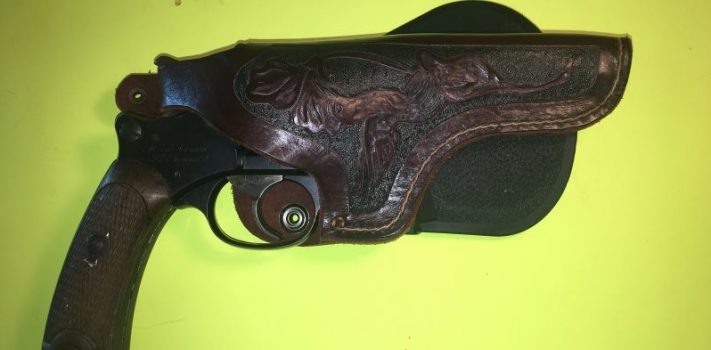









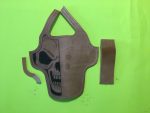
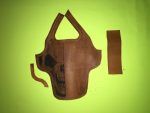
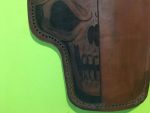

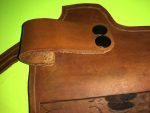
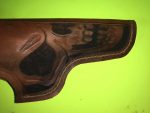
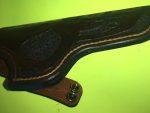
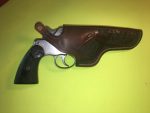

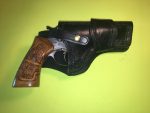
Why not purchase one of these for the stitching?
Youtube videos show it going through three layers of leather and it would greatly simplify the process.
https://www.amazon.com/Machine-Cobbler-Mending-Clothes-Trousers/dp/B07YHKFMSX/ref=pd_ybh_a_3?_encoding=UTF8&psc=1&refRID=CQE4VXKW37NVGBCA292B
Honestly Randy, I didn’t even know they existed. My experience tends to be with old boot and harness makers that had sewing machines worth several thousand dollars. Now I need to check these out and see how thick of leather they’ll sew. Shoe repair could be the next thing to learn for TEOTWAWKI.
Randy,
I’ve had one of those “Chinese Shoe Patcher” machines for three years and found it to be less useful than I thought it would be. The learning curve is very steep and requires a LOT of adjusting for your individual machine. Even with years of sewing machine mechanicing, it was a challenge since these are not manufactured to tight specifications. The only feed dog is on the presser foot so the layers will slide unless glued together first. (High end leather machines have feed dogs upper and lower to feed evenly.)
The machine is useful for “rough” work (tool belts, utility pouches, heavy canvas etc.) but not for “finished” look items like holsters and sheaths since it can’t accomodate 1mm threads and the stitch quality just isn’t anywhere near a neat saddle stitch.
Also the prices on these things has varied a whole lot. Three years ago it was $99, with no added shipping through Amzon, now the price is double-plus with hefty shipping charges most places. All that said, I do consider it a good tool around the homestead for heavy utility sewing and it is a useful non-electric skill in a grid down situation.
For garment weight leathers and general sewing, keep an eye out for Singers made up to the 1950s (tan color 300 and 400 series and earlier) since they have all metal gears and were all designed for simple treadle or hand-crank conversion even though they don’t look like treadle machines. My workhorse machine is a Singer 401A that is nearly 70 years old.
As a preparedness note, a heavy duty sewing machine is useless without heavy duty thread. Regular sewing threads will wear and break in thick materials so stocking up on good upholstery thread (synthetic to resist rot) is essential. The same goes for stocking the needles for the machine.
Thank you for sharing your experience. I will look into the the old singer machines.
Thanks for the link. I’ve been looking for something to use for leather working, particularly my shoe making/repairing I garnered some years ago.
Great article, and you do very nice work. I’m curious as to why you don’t design the holsters to cover the trigger and trigger guard. Wouldn’t that make them safer?
Yes? No? I’m really not sure. I’ve done holsters with the trigger guard covered. I’ve even done a military flap-style. With the thumb break, or a strap over the hammer you can’t pull the trigger, so it’s safe in that regard, and being a fixed firing pin, like in the “old west” you would always have an empty chamber under the hammer.
Again we come back to purpose or intent. If you’re going to carry it, you may need to use it. I just feel that an open trigger and thumb break is faster, although it does sacrifice some security.
Thanks for the article ! You have inspired me to go ahead and make the holster for my band new Remington black powder revolver.
Have you considered wrapping the gun in Saran Wrap when wet forming the holster?
Smart!
Steve, I have. I read an article years ago that suggested it. You could definitely do it, but I’m just pointing out not to trust it. Saran Wrap is pretty thin, and one small hole from a sharp edge and the integrity is gone. If you trust it, you could wind up with rust before you knew it.
Why not heavily oil it and THEN wrap it with Saran Wrap?
I don’t like rust either.
Really good article! Leather can be fun, functional, and frustrating…well done; detailed and informative.
Great job for a novice. I have been doing custom leather for 53 years, and currently make custom gun leather in Idaho. You seem to have learned “the right way”. Good article.
Dan: from somebody with your experience all that I can say is that I am humbled. Thank you for your kind words.
Your pattern is the same as I have used for many years. I have a press with HD foam that I shape them, but other than that….keep up the good work!
Hey LC, thanks again for taking time to write this article. I think too often people read the title and maybe the first paragraph of some articles and too quickly decide, “This doesn’t apply to me.” From where I’m sitting, this was an article about working with very thick materials using a leather holster as the example.
As I read this second part, I was thinking how many other applications this would have in a TEOTWAWKI situation. The concepts apply to any material which is very thick and not able to be sewn on your treadle Kenmore. I’ve tried sewing canvas before where there was a triple layer folded over, and it’s pretty difficult. Using some leather working tools and techniques would make the job easier.
When I think about a TEOTWAWKI setting, most of us won’t have enough shoes and boots in our preps so they’ll need patches and we’ll have to learn how to make new ones, even if they’re just moccasins, and our jeans will wear out in ways they don’t wear out now. For example, I used to carry a pair of 5″ vice grips in a scabbard on my belt. I lost the scabbard somehow and just carried them in my back pocket, which soon developed a large wear spot which turned into a hole which turned into lost vice grips. Some people carry a pistol in their pocket which will do the same thing to our jeans once more people are carrying after the SHTF. So making leather holders for those will not only give us quick access, but also slow down the wear and tear on our jeans. How many of us have large enough, strong enough needles to sew jeans or other heavy materials when making our own post-SHTF clothes? Leather-working needles are an excellent choice for some of that. And how about rifle slings that most of us don’t have? Those will be much more important post-TEOTWAWKI.
I saw a kid once and the back pocket of his jeans was lower and at an odd angle. Come to find out, he had a hole in the seat so his brilliant mother removed the pocket and shifted it to cover the hole. She was sewing through three layers of denim, the seat of the jeans and the folded-over pocket hem. Most of us lack treadle sewing machines and doing that post-SHTF will be much easier using leather working tools. When you think about it, these skills have a ton of applications in a grid-down, TEOTWAWKI world, and making a leather holster is just one use among hundreds.
I was also thinking this morning that of my 5 pistols, only one has a holster. You’ve inspired me to learn a new skill and I’ll be making some holsters as soon as I get some leather. I’ve seen leather-working tools at auctions but made the mistake of thinking, “I don’t do leather work.” If 3AD Scout doesn’t beat me to it, I’m going to bid on the next ones I see.
Thanks again for the article and the inspiration to learn a new skill. As I’ve said before, there’s a deep satisfaction that comes from learning new skills and knowing we can do things for ourselves, and we’ll feel our muscles bulge while looking at a finished item we’ve made or something we’ve fixed.
St. Funogas: great perspective. I guess that’s the true spirit of prepping. It’s surprising how often I learn a new skill in one area, and them find that it carries over into other areas. I think it’s the way I grew up. I was taught to think outside the box, and when it comes to fixing or repairing items this is invaluable.
As you point out, shoes will need to be patched/repaired. I’m thinking there will also be a lot more saddles and harnesses around post-TEOTWAWKI. There are no skills that we learn that are a waste of time – you just never know when they’ll come in handy.
Good work, Sir!
I concur that, on a revolver with an exposed and secured hammer, it is not necessary to cover the trigger. However, any holster that fails to secure the hammer, needs to cover the guard.
Certainly, proper carry methods are barely secondary to owning the tools. And I highly recommend that every working man or woman learn the basics of leather and thermoplastic.
For rifle slings–get yourself a 100-yard roll of polypropylene or nylon webbing, and at least 50 tri-glides (and, if possible, ladder-locks). Then stock up on swivel studs, and Uncle Mike’s-style quick-detach sling swivels. Once the gun has swivel studs on it in the correct places, you’re ready. Using two tri-glides (or one tri-glide and one ladder lock) on a suitable length of webbing, you have a sling in action with no stitching. And it can be disassembled just as easy.
For the classic Ruger 10-22– if you want an “across the front” 2-point tactical sling, take the screw out of the top of the buttplate, and replace it with a swivel stud. Then make sure you have enough webbing (5 or 6 feet). This makes a great setup for carrying a rifle on the riding lawnmower, when the rodents are out!
And a last sling-related item– my great-grandfather was known for putting slings on about everything by taking a leather thong, slitting one end, putting a cinch around the barrel behind the front sight, and then securing the opposite end around the wrist of the stock behind the pistol-grip. It carried a bit low in the traditional position, but also doubles quite well for tactical carry across the chest.
I just set one up using paracord instead of leather thong.
If you want an inexpensive stitching tool for thick materials such as leather, why not try an sewing awl? A professional leatherworker who makes scabbards for swords and knives recommended this tool to me, and I’ve used it to repair sheepskin boots, make a leather sporran for my ren-faire costume, and repair the straps on my son’s backpack. It saves constantly stabbing yourself with the eye-end of the needle or the constant breakage of a leather hand needle and, with a bit of practice, the stitches come out looking nice and straight like they were machine-sewn.
HERE: https://www.amazon.com/dp/B000HGIJQ4/